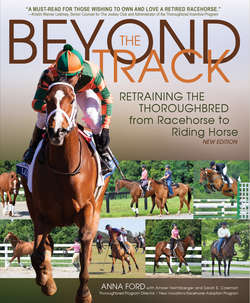Читать книгу Beyond the Track - Anna Morgan Ford - Страница 16
На сайте Литреса книга снята с продажи.
Two-Year-Olds
ОглавлениеThoroughbreds may also be prepped for the “two-year-old-in-training” sales, where not only conformation and pedigree are taken into account, but also performance. At these sales, potential buyers may arrive several days early to see each horse gallop a timed two furlongs on the track; the faster the horse, the higher the likely purchase price.
As with those prepped for yearling sales, two-year-olds-in-training are also stabled, groomed, and exercised daily for several months prior to the sale. However, these horses have to develop mental toughness early and be able to handle stress well—above and beyond that required of yearlings. So, those intended for two-year-old-in-training sales are usually also broke to saddle at the end of their yearling year—in the fall or the winter—as the first sales of the season start as early as February.
When you are researching prospective OTTBs’ backgrounds, it may be desirable to consider one that went through the two-year-old-in-training sales because many of these horses tend to be easier to handle and teach new skills. But, bear in mind the possible negative side effects to this fast-track training: while this early education does give these particular horses a head start in their riding horse educations (should they retire from the track early), it also imposes more pressure and physical strain at a young age. Plus, so much time indoors early in life encourages some horses to develop bad habits, and a few act out because they are asked to do too much, too soon. Conscientious trainers notice this and withdraw such anxious horses from the sales prep or regular training, opting instead to turn them out to pasture for a while and re-enter the training program later in their two-year-old year. However, some trainers push their horses and deal with the consequences later.
